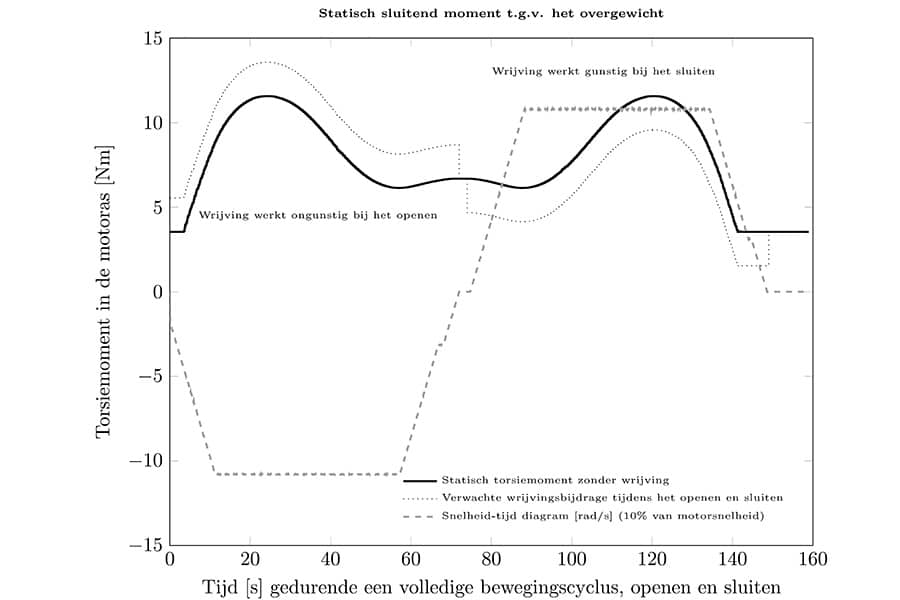
Groundbreaking dynamics research on movable bridges
New calculation methodology that predicts dynamic loads validated
When re-evaluating existing movable bridges, the movement system soon comes under consideration for replacement. Current calculation rules are based on simplified calculation models with theoretical assumptions, which do not represent all aspects of the real situation. In a doctoral research project at Delft University of Technology, Kodo Sektani, an Artworks consultant at Antea Group, developed a new calculation methodology that better predicts the acting force in the actuator during the full movement cycle. After an extensive verification study based on laboratory measurements, the calculation method has now also been successfully validated in practice for the Croles Bridge in Bodegraven, a bascule bridge with panama wheel construction. An important step towards wider application in practice!
Bridge movement mechanisms are generally a major cost in replacement and renovation. When conservation is technically sound, it results in significant social savings and a much more sustainable outcome. Yet too often it still happens that these mechanical components are written off prematurely, when in practice no degradation is yet observable. Current regulations divide the motion cycle into separate scenarios with simplified assumptions. According to Sektani, that approach does not always match the actual dynamics of the motion work, which in some cases results in overruns being calculated that are not representative of real-world conditions.

More focused assessment
The new calculation methodology offers a more realistic alternative. It accurately predicts the force effects in drivelines under a variety of conditions - from normal operation to emergency braking. This provides a more reliable basis for both strength and fatigue considerations. The model itself makes no distinction in this regard, but allows users to relate, for example, peak loads to extreme limit states and load cycles to damage factors for fatigue estimation purposes. "We can now assess much more specifically whether replacement is really necessary," says Sektani, who conducted the research on behalf of Antea Group as part of his doctorate at TU Delft.
Verification and validation
The research has been ongoing for several years - and rightly so, because good work takes time. As part of the research into the dynamics of movable bridges, Sektani has created a numerical calculation method that more realistically approximates dynamic loads in movable bridges. The methodology was developed in MATLAB and then verified using accurate measurements and laboratory tests at TU Delft. "The measurement setup we used for verification is very suitable for collecting data and measurement data in a reliable and reproducible way," Sektani says. "That experimental study showed that the calculation results are correct. This verified the calculation methodology. In 2024, I also validated the methodology in practice to assess its applicability under realistic conditions."

Peak load insight
As part of the validation study, a measurement was performed on the Croles Bridge. "The study focused specifically on mapping the dynamic loads in the motion works that occur during the opening, closing and emergency braking of the bridge," explains Sektani. "Especially at the level of the motor shaft, just before the flywheel, substantial peak loads occur during acceleration and deceleration. Current calculation rules consider this peak to be normative for the entire drive train, whereas in reality it only occurs locally. Further down the driveline, the normative loads are sometimes four to five times lower. This systematic overestimation is due to some inaccurate assumptions on which the calculation rules are based. This has now also been demonstrated in practice with measurements on the Croles Bridge. Measurements on the Croles Bridge show that the mathematically predicted peak load actually manifests itself as internal torque at the block brake, and hardly at all in the drive itself. This finding supports the choice of a single mass spring system, in which the bridge - and not the actuator - plays the dominant role in determining the loads."

Better decision-making
The results confirm that significant load reductions in the powertrain can be achieved through more targeted calculations. "This leads to better decisions in management and maintenance," Sektani concludes. "This allows us to avoid unnecessary rejection of motion works or overdimensioning." According to Sektani, it is important that similar validation studies are also conducted for other types of movable bridges and movement works. "We now have approval from the City of Amsterdam to start measuring on a drawbridge with rack arrangement. In the future, I would also like to investigate swing bridges."
Revision of calculation rules
Ultimately, the goal is to translate the findings from this study into widely applicable rules for the design and assessment of movable bridges. The current calculation rules in NEN 6786 can be revised based on this. This will create a more realistic and reliable basis for new calculation rules in the Netherlands. A logical next step is to set up a technical committee of experts to evaluate, implement and share the research results with bridge managers and other stakeholders.



